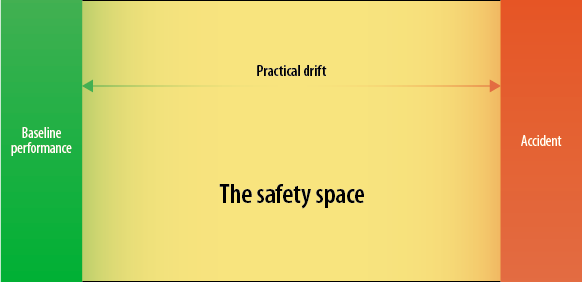
In everyday operations, aviation organizations operate in what is known as the “safety space.” The safety space is a continuum between baseline performance on the left of the continuum and an accident on the right (Figure 1). Fortunately, the safety space is quite wide and has a large margin of error tolerance.
Within this safety space, practical drift inevitably occurs. Practical drift is dynamic and can shift significantly within a short period of time. When there’s right drift, safety is deteriorating, which may lead to an accident. When there’s left drift, safety is improving, possibly to baseline performance. Baseline performance means that an organization is doing everything by the book. All policies, rules, regulations, procedures, etc. are being followed to the letter. Thus, theoretically, the chance of having an accident or incident is extremely low. In reality, an organization rarely achieves, and/or maintains, baseline performance. The closest an organization may come to baseline performance is when operations first begin, during external audits, during inspections by the U.S. Federal Aviation Administration, or immediately following an accident or incident. In a perfect world, all organizations would perform at baseline all the time. In practicality, this will not happen. People tend to deviate from, and/or fail to follow, policies, rules, regulations and procedures. Most accidents occur not because of a lack of procedures, policies, checklists, etc., but rather because those procedures and policies are not being used. To make matters worse, deviations from written procedures tend to become cultural norms (routine violations).
If practical drift progresses too far to the right of the scale, then the likelihood of an accident or incident increases. If an accident occurs, then typically the organization will make immediate corrections to try to achieve baseline performance. In other words, the needle will go from the extreme right side of the scale to the extreme left side in a very short period of time. This was the case in the crash of Continental Express Flight 2574, an Embraer 120 that crashed in Texas in 1991, killing all on board. The crash occurred because, during a shift turnover, the outgoing maintenance shift did not inform the incoming shift that 47 screws needed to be put back on the horizontal stabilizer. Slack shift turnovers were the norm, and although there were procedures in place to safely conduct shift turnovers, they were not being used. This is an example of practical drift in which the needle goes too far to the right and an accident occurs. Unsurprisingly, the airline attempted to go back to baseline performance immediately after the accident.
Unfortunately, even with accidents and significant safety events, organizations will, over time, drift back to the right. The question is where is your organization in the safety space right now? If the needle is too far to the right, you may want to start making a left correction!
Bob Baron, Ph.D., is the president and chief consultant of The Aviation Consulting Group (TACG), and specializes in human factors, safety management systems, crew resource management, line operations safety audits and fatigue risk management.
The opinions expressed are the author’s and do not necessarily reflect the Flight Safety Foundation’s views.

